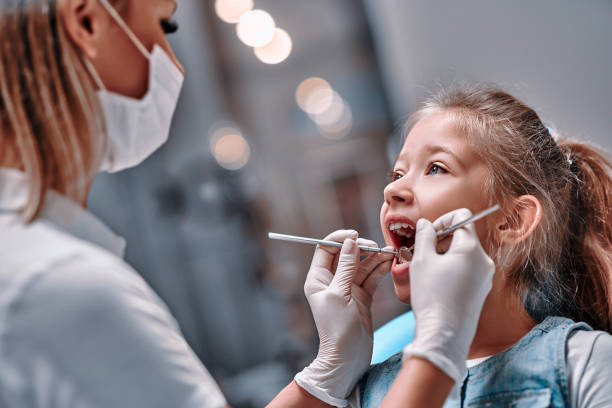
Why Early Orthodontic Checkups Are Important
Early orthodontic checkups play a vital role in safeguarding your child’s dental health and setting the foundation for a lifetime of healthy smiles. By addressing potential orthodontic concerns at a young age, parents can help ensure their child’s jaw and teeth develop in proper alignment. This proactive approach can prevent more serious issues from developing in the future.
The role of orthodontics in childhood dental health
Orthodontics isn’t just about straightening teeth it’s about guiding the growth and alignment of the jaws, improving bite function, and supporting overall oral health. When issues like misaligned bites or narrow arches are addressed early, they can be corrected before they become more severe or harder to treat.
How early evaluation supports proper jaw growth and bite alignment
A child’s jaw is still developing during the early years, which makes it more responsive to orthodontic intervention. Early evaluations allow orthodontists to monitor jaw growth, ensure teeth erupt in the right positions, and make adjustments that encourage a balanced bite. This can help avoid uneven wear on teeth and discomfort later in life.
Benefits of detecting orthodontic issues early
Detecting orthodontic issues early means treatment can often be simpler, shorter, and more cost-effective. Early detection may prevent the need for surgery, reduce the complexity of future orthodontic care, and help children maintain confidence in their smiles during their formative years.
Ideal Age for a Child’s First Orthodontic Evaluation
Knowing the right time for your child’s first orthodontic evaluation can make a world of difference in their oral development. By scheduling this initial visit at the recommended age, parents can ensure any concerns are caught before they become complicated problems.
American Association of Orthodontists recommendation (by age 7)
The American Association of Orthodontists advises that children should have their first orthodontic evaluation by age 7. At this age, permanent teeth are beginning to emerge, and orthodontists can spot subtle issues in jaw growth and tooth alignment that may not be visible to the untrained eye.
Why this age is critical for dental development
Around age 7, a child’s mouth contains both baby teeth and permanent teeth, making it the perfect time to assess how the two sets are working together. This mixed dentition stage provides valuable insight into how the permanent teeth will come in and how the jaws are growing.
Factors that may require an earlier visit
Some children may benefit from an orthodontic evaluation before age 7. Factors such as thumb-sucking, difficulty chewing, speech problems, or visible jaw misalignment can indicate the need for an earlier assessment to prevent more serious issues later on.
Signs Your Child May Need an Early Braces Assessment
While only a trained orthodontist can provide a definitive diagnosis, there are several signs parents can watch for at home. Identifying these early can help you take action before small issues become major challenges.
Difficulty chewing or biting food
If your child struggles to bite or chew properly, it could be a sign that their teeth or jaws are misaligned. This may lead to discomfort during meals and impact overall nutrition.
Thumb-sucking or prolonged pacifier use
Habits like thumb-sucking or extended pacifier use can put pressure on the developing teeth and jaws, causing them to shift out of alignment. The earlier these habits are addressed, the better the outcome for your child’s smile.
Speech difficulties related to teeth positioning
Teeth that are out of position can affect the way your child forms sounds and words. Lisping, slurring, or difficulty pronouncing certain letters may indicate an orthodontic concern.
Crowded or gapped teeth
Crowded teeth can make it hard to brush and floss effectively, increasing the risk of cavities and gum problems. Large gaps can also signal underlying bite or jaw issues that need attention.
Noticeable jaw misalignment
If your child’s jaw appears to shift when opening and closing or if their chin looks off-center, it may be due to uneven jaw growth. This is often best addressed early while the jaw is still developing.
Common Issues Detected in Early Orthodontic Evaluations
An early evaluation allows orthodontists to detect and address a wide range of dental and jaw issues before they become more serious. By catching these problems early, treatment can often be more efficient and less invasive.
Overbite, underbite, and crossbite
These bite problems can affect chewing, speech, and the overall function of the mouth. Early correction helps prevent abnormal wear on teeth and discomfort in the jaw.
Narrow dental arches
A narrow upper or lower arch can lead to crowding and misalignment of teeth. Early expansion treatments can create the space needed for permanent teeth to come in properly.
Impacted teeth
Sometimes permanent teeth become blocked from erupting due to lack of space or improper positioning. Identifying impacted teeth early allows for timely intervention.
Jaw growth discrepancies
When the upper and lower jaws grow at different rates, it can cause facial imbalance and functional problems. Early orthodontic care can help guide growth for better symmetry and function.
Understanding Interceptive Orthodontics
Interceptive orthodontics focuses on diagnosing and treating developing problems in young children. The goal is to intercept and correct these issues before they progress into more severe conditions.
What interceptive orthodontics means
This approach involves using orthodontic techniques at an early stage to guide the growth of a child’s teeth and jaws. It’s not always about putting braces on right away but about setting the stage for future alignment.
How it differs from full orthodontic treatment
Full orthodontic treatment usually happens when most or all permanent teeth are present, often during the teenage years. Interceptive orthodontics, on the other hand, happens earlier and may involve partial braces, expanders, or other appliances to guide development.
Examples of early interventions
Examples include palate expanders to widen a narrow jaw, partial braces to correct crossbites, or space maintainers to hold space for permanent teeth after premature loss of baby teeth.
How Early Treatment Can Prevent Future Complications
Addressing orthodontic concerns early can significantly reduce the need for complex treatments later on. It can also improve oral health, function, and aesthetics during your child’s formative years.
Reducing the need for extractions later
Creating adequate space for permanent teeth early on can help avoid the need for extractions in the future.
Shortening future orthodontic treatment time
When early interventions correct growth patterns and spacing issues, the length of time needed for full braces as a teen is often reduced.
Supporting healthy facial development
Proper jaw growth and tooth alignment contribute to balanced facial proportions and a more confident smile.
The Role of Pediatric Orthodontics at Hamilton Dental Group
At Hamilton Dental Group, we specialize in making children’s orthodontic experiences comfortable and stress-free. Our goal is to create a positive environment where young patients feel at ease while receiving expert care.
Child-friendly evaluation process
Our team takes the time to explain each step in language children can understand, ensuring they feel safe and confident during their visit.
Customized treatment plans for growing smiles
Every child’s mouth is unique, which is why we create treatment plans tailored to their specific growth and developmental needs.
Coordinating with pediatric dental care
We work closely with your child’s regular dentist to ensure that their orthodontic care complements their overall dental health.
Conclusion
An early orthodontic evaluation is one of the most valuable steps you can take to ensure your child’s long-term dental health. By identifying and addressing potential problems early, you can make treatment easier, faster, and more effective. Early detection supports proper jaw growth, prevents complex issues, and sets the stage for a confident, healthy smile.
Schedule your child’s first orthodontic evaluation with Hamilton Dental Group today to give them a healthy, confident smile for life. Contact us to book an appointment.
FAQs – Early Orthodontic Evaluations
1: At what age should I first take my child to an orthodontist?
By age 7, according to the American Association of Orthodontists.
2: Does early evaluation mean my child will get braces right away?
Not necessarily—many children simply need monitoring until the right time for treatment.
3: How can I prepare my child for their first orthodontic visit?
Explain that the orthodontist will simply look at their teeth and jaw, and there’s nothing to be afraid of.
4: Are early orthodontic treatments painful?
Most cause mild discomfort at first, which usually goes away within a few days.
5: How often will follow-ups be needed after an initial evaluation?
Follow-ups may be scheduled every 6–12 months to track growth and development.



